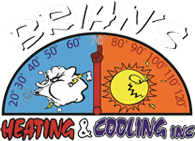As with most components of your HVAC system, your furnace is a complicated piece of machinery. Understanding how your furnace works may seem difficult. This is an important task to take on, however, as a basic understanding can help you diagnose problems. To explain how a furnace works, we’ve detailed the function of the main parts.
Burners
In gas furnaces, the burners are typically fueled by natural gas that is ignited by a pilot light. The burners are placed near the bottom of the furnace since heat rises naturally, resulting in increased efficiency. In electric furnaces, the heat comes from wires that slow down the flow of electricity, heating up in the process. In an electric furnace, the air simply passes over the hot coils and is sent through the supply ducts. A gas furnace, on the other hand, uses the flames to increase the temperature of a heat exchanger. Air is then sent past this component to warm it before it enters the supply ducts.
Blower
Without the blower motor, no air would enter the furnace to be warmed. The blower is unique in that it operates when either the furnace or air conditioner is on, drawing air in for both units. This component uses a powerful fan that spins rapidly, drawing air in through the return vent. As the air passes over the fins of the fan, it is accelerated to a high speed, giving it enough velocity to pass through the furnace and travel through the supply ducts to the various rooms in your home.
Don’t Neglect Problems
Given that the burners, heat exchanger, blower, and other components of your furnace are all fairly complex in and of themselves, you can see how it can become difficult to diagnose an issue. That’s why it’s important to contact Brian's Heating & Cooling, Inc. if your furnace is acting up. That way, you can ensure you’ll have a working furnace when you need it most. Call us today for the professional service you deserve. We provide a variety of heating and cooling services for residents of Madera.

